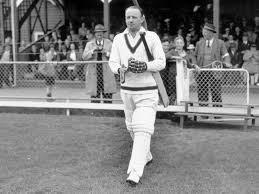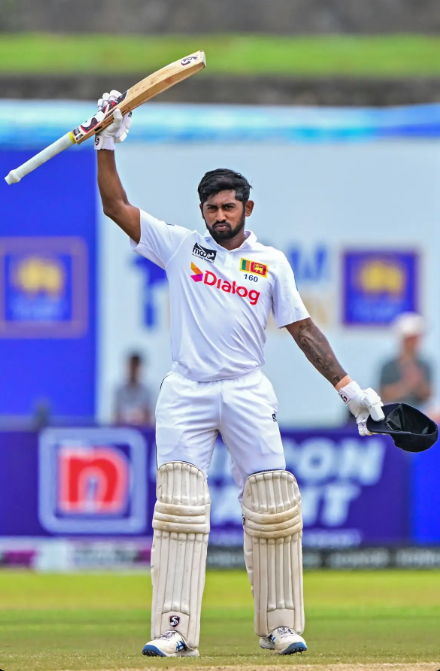The Fastest People to 1000 Test runs
UncategorizedKamindu Mendis may have ben Making headlines with his remarkable and sparkling run of form, reaching 1000 test runs in just 8 innings, but who are the rest of the ones who have access to this remarkable club? Find out in this blog
#1 – Herbert Sutcliffe

Herbert Sutcliffe was one of the great cricketers and he brought to cricket as to all his undertakings an assurance and capacity for concentration that positively commanded success. His technical talent matched his character and his achievements were therefore on the highest plane.
In a career extending from 1919 to 1939 Herbert Sutcliffe scored more than 50,000 runs and averaged 52. He never knew a season of failure, except by the standard of his own astonishing peaks, and at the zenith of his career he scored 16,255 runs in five years as a measure of mastery in all conditions and over the world’s best bowling of the time.
The First World War delayed his entry into county cricket until he was 24 years old when, after demobilisation from a commission in the Green Howards, he was given a place in the Yorkshire side. His quality was never in doubt and by the end of the 1919 season he had scored five centuries in an aggregate of 1,839 runs. He had also established a first-wicket partnership with Percy Holmes. For fourteen years these two batsmen opened the innings for Yorkshire, representing a partnership of unparalleled success in which they put up the hundred on 74 occasions. Equally happy was Sutcliffe’s Test match association with J. B. Hobbs, for this became the most accomplished of all opening partnerships. Sutcliffe’s good fortune, however, was only in the presentation of opportunity. Seizure of it was his own merit and with one partner or another he constructed 145 first-wicket century stands.
His artistry and efficiency in difficult conditions became legendary in his lifetime, with his centuries against Australia at The Oval in 1926 and at Melbourne in 1929 as historic examples. Matches against Lancashire stirred him to nine centuries. His defensive patience and skill became a byword, yet at need his hitting was brilliant in the extreme. Against Northamptonshire at Kettering he met spin on the sticky wicket with an innings of 113 which included ten 6s. At Scarborough against the fast bowling of Farnes and Nichols, Sutcliffe took his personal score from 100 to 194 in forty minutes. His 100th first-class century was the 132 he hit in less than two hours at Bradford when Yorkshire were hurrying to defeat Gloucestershire.
Courage and concentration were his basic attributes. No prospect daunted him, no difficulty dismayed him, no crisis upset him. He was an artist of the dead bat and an uncompromising hooker of fast bowling. He sought solution to his batting problems by taking them as they came, one at a time. He never allowed the present to be influenced by the alarms of the past or fears for the future. In the means and manner of his performances he raised enormous prestige for himself throughout the cricketing world. He was admired and respected wherever he played and by his refusal to depreciate his own value he raised the status of his profession.
He took the supplementary rewards of his distinction with polished grace and unfailing consideration for colleagues. Herbert Sutcliffe the individual always made it clear that he was Herbert Sutcliffe inseparable from Yorkshire and England. He was as punctilious in acknowledgment of obligations as he was single-minded towards the immediate task in hand.
After the retirement of A. W. Lupton in 1927, Sutcliffe was offered the Yorkshire captaincy as a professional player. Although he was on tour in South Africa when the invitation came he appreciated the possibility of divided opinions and with characteristic diplomacy declined the appointment, giving an insurance of his willingness to play under any captain.
During his playing days he founded and developed a sports outfitting business, now directed by his elder son. After his retirement from the field he took a managerial appointment in the paper trade. He showed himself as successful in commerce as in cricket and for the same reasons of application and reliability. His repayment to the game which had given him so much was service on the Yorkshire committee, as an England selector, and as sponsor for many good causes in cricket.
he reached 1000 runs in just 9 matches, (Kamindu reached it in 7) however, he got it in only 12 innings.
#2- Everton Weeks

Short, stocky but endearing, Everton Weekes, one of the three Ws, was quick-footed and possessed an admirable variety of strokes, almost all of them attacking. His debut against England in 1947-48 was unremarkable, and he was dropped to make way for George Headley, although he was restored when Headley had to drop out. The Kingston crowd wanted John Holt instead of Weekes, and he was booed throughout the England innings. He responded with 141, and on the tour of India which followed he scored 779 runs at 111.28 and set a world record of five successive hundreds, the highest being 194 at Bombay. It would have been six were it not for a controversial run-out decision at Madras. In England in 1950 his rich form continued with 2310 runs at 79.65 on the trip, including a triple hundred against Cambridge, although in the Tests he made only 338 at 56.33. His form returned from superlative to good on the tour to Australia which followed, but against India at Port-of-Spain in 1952-53 he made 207 in the first Test and another big hundred on the same ground in the third Test. He scored heavily against England in 1953-54, and in New Zealand in 1955-56 he hammered 940 runs at 104.44 in eight first-class matches. His tour of England in 1957 was blighted by poor health, and aside from a gutsy 90 on a lively Lord’s wicket, when he was struck a painful blow on the hand, he disappointed. Against Pakistan in 1957-58 he returned to form but he was increasingly troubled by a thigh injury, and after an unsuccessful operation he decided to retire even though he was still in his early 30s. Weekes also played in English League cricket, toured with various Commonwealth sides, coached in Barbados, was awarded the MBE and the CBE, and also served time as an ICC referee. In 1995 he was the last of the three Ws to be knighted.
#3: Don Bradman

Donald Bradman of Australia was, beyond any argument, the greatest batsman who ever lived and the greatest cricketer of the 20th century. Only WG Grace, in the formative years of the game, even remotely matched his status as a player. And The Don lived on into the 21st century, more than half a century after he retired. In that time, his reputation not merely as a player but as an administrator, selector, sage and cricketing statesman only increased. His contribution transcended sport; his exploits changed Australia’s relationship to what used to be called the “mother country”.
Throughout the 1930s and 40s Bradman was the world’s master cricketer, so far ahead of everyone else that comparisons became pointless. In 1930, he scored 974 runs in the series, 309 of them in one amazing day at Headingley, and in seven Test series against England he remained a figure of utter dominance; Australia lost the Ashes only once, in 1932-33, when England were so spooked by Bradman that they devised a system of bowling, Bodyline, that history has damned as brutal and unfair, simply to thwart him. He still averaged 56 in the series.
In all, he went to the crease 80 times in Tests, and scored 29 centuries. He needed just four in his last Test innings, at The Oval in 1948, to ensure an average of 100 - but was out second ball for 0, a rare moment of human failing that only added to his everlasting appeal. Bradman made all those runs at high speed in a manner that bewildered opponents and entranced spectators. Though his batting was not classically beautiful, it was always awesome.
#4- Neil Harvey

One of Australia’s all-time favourite cricketing sons, Neil Harvey was a gifted left-hand batsman, brilliantly athletic fielder, and occasional offspin bowler. On account of the richness of his talents, he served Victoria, New South Wales and Australia with great distinction during a first-class career which spanned the 16-year period between 1946-47 and 1962-63.
In short, Harvey was an electrifying batsman who thrilled spectators with the splendour of his strokeplay. He possessed a masterful technique as well as a full range of shots and he displayed to cricket followers a superbly steadfast temperament right from the moment, as a teenager, that he played his opening first-class innings. Throughout a career which ultimately netted him in excess of 20,000 first-class runs, bowlers rarely found a way of disrupting his concentration or curbing his attacking instincts. He also possessed disarming power for a man of relatively short height. There will be many performances for which he will be remembered but foremost among them were his 153 against India in his second Test (an innings which made him the youngest-ever Australian to score a Test century); his 112 in the celebrated Leeds Test of 1948; his 151 in Durban in 1949-50; and his highest Test score of 205 against South Africa in Melbourne in 1952-53. Most discussions of Neil Harvey’s career are also considered to be incomplete without mention of his achievement in amassing six centuries in his first 13 Test innings alone.
In later times, Harvey continued to play a role at the forefront of Australian cricket as a national selector for a period of 12 years, and it was during the middle of this period (namely, the mid-1970s) that the country fielded one of its most successful ever sides at international level. In recognition of his string of outstanding achievements in the game, he was inducted into the Australian Cricket Hall of Fame in early 2000. He was also selected in the Australian Cricket Board’s official Test Team of the 20th Century.
#5- Vinod Kambili

Born and bred in Mumbai, Vinod Kambli’s flashy strokeplay, flamboyant personality and fondness for gold jewellery were more West Indies than West India. A precocious talent, he was 17, and Sachin Tendulkar 16, when they put on a world-record unbroken 664-run partnership in a school match. Kambli started his Test career three years after Tendulkar, and three years after he had hit the first ball he received in the Ranji Trophy for six. But what a start it was: in his first seven Tests he racked up two double-centuries and two single ones. His footwork was dazzling against the spinners – he once smashed Shane Warne for 22 runs in an over – but he often got himself into a tangle against the short ball, and his flash to gully soon became a trademark. Kambli’s problems were compounded by indiscipline and an obsession with the width of his bat-handle, which had nine grips on at one time. He made as many as nine comebacks into the one-day team, but played his last Test in 1995 before he had turned 24. He wasn’t picked in the Indian ODI team after October 2000 and retired from international cricket in 2009. He announced his retirement from first-class cricket in 2011.
